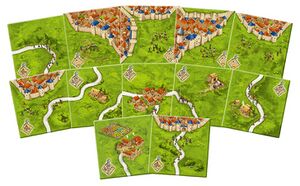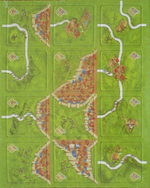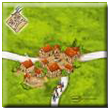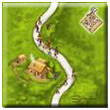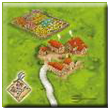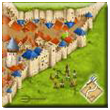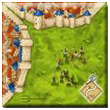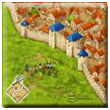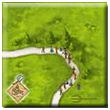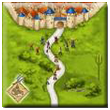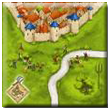Powstanie chłopów
 |
You are reading the rules for this tile design. |
| If your tiles have a different design, then choose a game from Spin-offs. |  |
In this mini-expansion you have to decide, whether you want to protect yourself against insurgent peasants (and hence direct their anger against your fellow players) or rather take things as they come.
General info and comments
The Peasant Revolts was released by Hans im Glück in 2020.
This expansion doesn't exist for the 1st edition (C1 for short) or the 2nd edition (C2 for short).
This expansion has cities with clipped buildings.
The 1st print of this expansion was sold in shrink wrap. The 2nd print, from 2024, came in a paper envelope.
Contents
- 12 new land tiles for peasant revolts with symbols for the respective features.
Rules
Preparation
Shuffle the 12 land tiles of this mini-expansion. Put 3 of them back into the box (without looking at them). Those tiles will not be used in this game. Shuffle the remaining 9 tiles and the other land tiles together.
Gameplay
1. Ułożenie płytki
The peasants revolt
As soon as you draw a peasant revolt tile, a revolt takes place. Place the tile in front of you. [1] Now check, if one or more of your meeples are standing on features shown on the diamond-shaped symbol of the tile (city, road or
monastery), and if those meeples are "unprotected" or "protected".
(How you can protect your meeples, will be explained in 2. Wystawienie podwładnych.)
Note: If you had to return at least one meeple, the revolt is over and you continue with your normal turn.
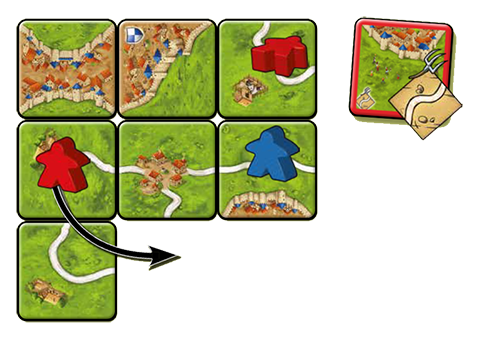
Your protected meeple on the right stays on the tile and scores 2 points.
Your unprotected meeple is standing on a road on the left. Put the meeple back into your supply.
Therefore the revolt is over. The blue meeple has not been affected.
Now, place the land tile according to the usual rules and continue your turn.
The peasant revolt moves on to the next player
If you do not have to return a meeple to your supply, the peasant revolt moves on and hits the player to your left. They also check, in the same way as described before, whether or not the revolt affects them and if they score points for protected meeple. If the player doesn't have to take back a meeple, the next player in line checks meeples in these features and so on.
This continues until a player has to return at least 1 meeple to their supply, or none of the players have been affected. Now, place the land tile according to the usual rules and continue your turn.
Note! Only players who have to check their meeples during the peasant revolt score points for their protected meeples. Players who are not hit by the peasant revolt cannot score any points for protected meeples.

The peasant revolt moves on to Blue. Blue is sitting to your left, and continues to check if and how the peasant revolt affects them. Blue has 1 protected meeple in the city on the left, which scores 2 points. The unprotected meeples have to be returned to Blue's supply. The revolt ends and you place the land tile according to the usual rules and continue your turn.
2. Wystawienie podwładnych
Protecting a meeple from a peasant revolt
If you place a meeple on the tile just placed, you may also protect this very meeple for the cost of 4 points. To do so, move your meeple on the scoreboard back by 4 spaces. It is possible to score negative points. Next, "lay down" this meeple. (This meeple has now joined the farmers.) [2] A meeple "lying down" is protected from a peasant revolt.
Each time you do not place a meeple on the tile you just have placed, [3] you may protect one of your meeples standing on tiles for the cost of 2 points. Farmers cannot be protected, however they are never affected by peasant revolts.
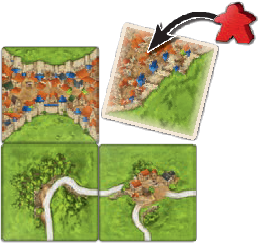
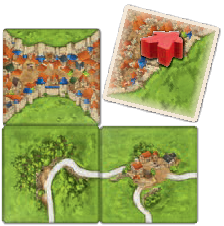
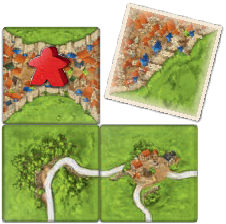
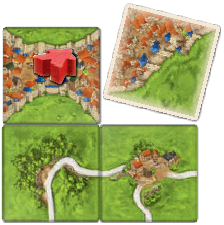
3. Punktacja
When scoring a feature, a protected meeple is treated like an unprotected meeple. It is returned into your supply after the feature has been scored. After that, it loses its protection from peasant revolts. This means, that if you place that meeple again, it is unprotected once again.
Punktacja końcowa
Final scoring is performed according to use usual rules. When scoring a feature, a protected meeple is treated like a normal meeple.
Other expansions
This section contains additional information about the interactions with other Carcassonne expansions.
- Meeples may be protected when placed on or moved to any feature for 4 points in any phase:
- Phase 1. Placing a tile:
- Swapping meeples with La Porxada (
 La Porxada)
La Porxada) - Placing meeples with a Synod gift card (
 Prezenty)
Prezenty) - Placing a meeple on a feature with a Change Position gift card (
 Prezenty)
Prezenty)
- Swapping meeples with La Porxada (
- Phase 2. Placing a meeple:
- Placing meeples (including the phantom) directly (see
 Świta)
Świta) - Placing meeples with magic portals (
 Rozszerzenie 3. - Księżniczka i Smok)
Rozszerzenie 3. - Księżniczka i Smok) - Placing meeples with flying machines (
 Mini #1 - Maszyny latające)
Mini #1 - Maszyny latające) - Placing a meeple with the 20th Anniversary Expansion (
 Rozszerzenie Jubileuszowe)
Rozszerzenie Jubileuszowe) - Adding a meeple with the 20th Anniversary Expansion (
 Rozszerzenie Jubileuszowe)
Rozszerzenie Jubileuszowe)
- Placing meeples (including the phantom) directly (see
- Phase 3. Scoring a feature:
- Moving a wagon (
 Rozszerzenie 5. - Opactwo i burmistrz)
Rozszerzenie 5. - Opactwo i burmistrz) - Redeploying meeples from Carcassonne (
 Rozszerzenie 6. - Hrabia, Król i Rzeka), although pointless
Rozszerzenie 6. - Hrabia, Król i Rzeka), although pointless - Moving a meeple into a city via a drawbridge (
 Mosty zwodzone)
Mosty zwodzone)
- Moving a wagon (
- Phase 4. Additional actions:
- Swapping meeples with the Seduction Token (
 Rozszerzenie 7. - Katapulta)
Rozszerzenie 7. - Katapulta) - Placing meeples with crop circles (
 Mini #7 - Kręgi w zbożu)
Mini #7 - Kręgi w zbożu)
- Swapping meeples with the Seduction Token (
- Phase 1. Placing a tile:
- Meeples placed on any feature may be protected for 2 points in phase 2. Placing a meeple.
![]() Rozszerzenie 3. - Księżniczka i Smok
Rozszerzenie 3. - Księżniczka i Smok
![]() Rozszerzenie 5. - Opactwo i burmistrz
Rozszerzenie 5. - Opactwo i burmistrz
![]() Pytanie: When does a meeple lose its protection against peasant revolts?
a) When the feature is scored (the meeple is still on the board)
b) When the meeple is placed in the player's supply
Pytanie: When does a meeple lose its protection against peasant revolts?
a) When the feature is scored (the meeple is still on the board)
b) When the meeple is placed in the player's supply
Odpowiedź: A meeple loses its protection in the moment when you take the meeple back in your supply. (1/2021)
![]() Pytanie: Should we consider a protected wagon still protected if moved to another feature after scoring?
Pytanie: Should we consider a protected wagon still protected if moved to another feature after scoring?
Odpowiedź: In the special case of the wagon, you can consider that the wagon keeps the protection after moving. (1/2021)
![]() Pytanie: The wagon should then keep its protection until it returns to the player's supply. Even it is placed on features that can't be affected by a peasant's revolt. Is this correct?
Pytanie: The wagon should then keep its protection until it returns to the player's supply. Even it is placed on features that can't be affected by a peasant's revolt. Is this correct?
Odpowiedź: Yes, you can do so. The rules are always be made for the base game. We haven't given any thought to all of the (mini)-expansions and the special cases yet. (1/2021)
![]() Pytanie: Since a wagon can move, would it be possible to protect a wagon when placed on a feature other than a road, city or monastery?
Pytanie: Since a wagon can move, would it be possible to protect a wagon when placed on a feature other than a road, city or monastery?
Odpowiedź: There is no reason to do it. (1/2021)
![]() Only the active player can protect a wagon moved after scoring when moving it after scoring. The active player will pay 4 points.
Only the active player can protect a wagon moved after scoring when moving it after scoring. The active player will pay 4 points.
![]() Pytanie: When moving an unprotected wagon, can it be protected? If so, should we pay 2 (wagon was already placed) or 4 points (new placement)? Would this be applicable to all players even if it is not their turn?
Pytanie: When moving an unprotected wagon, can it be protected? If so, should we pay 2 (wagon was already placed) or 4 points (new placement)? Would this be applicable to all players even if it is not their turn?
Odpowiedź: You can protect only in your turn. So if you move the wagon in a turn of other players, you can not protect it. How much it costs, is written in the rules (4 points). (1/2021)
![]() Rozszerzenie 6. - Hrabia, Król i Rzeka
Rozszerzenie 6. - Hrabia, Król i Rzeka
![]() Pytanie: Are meeples placed in the city of Carcassonne affected by peasant revolts?
Pytanie: Are meeples placed in the city of Carcassonne affected by peasant revolts?
Odpowiedź: As written in the rules, there are no official rules for the combination. The meeples placed in the city of Carcassonne are not affected by the peasants revolts. (1/2021)
![]() You may protect a meeple redeployed from Carcassonne to a feature being scored although it makes no sense, since it will be scored and removed right away. So, no peasant revolt can affect it at that point. However, players may decide to spend 4 points in the process.
You may protect a meeple redeployed from Carcassonne to a feature being scored although it makes no sense, since it will be scored and removed right away. So, no peasant revolt can affect it at that point. However, players may decide to spend 4 points in the process.
![]() Pytanie: It makes no sense to protect meeples redeployed from the city of Carcassonne, right? I would say no as they are scored immediately.
Pytanie: It makes no sense to protect meeples redeployed from the city of Carcassonne, right? I would say no as they are scored immediately.
Odpowiedź: You are free to lower your score by that method. It also makes no sense. (1/2021)
![]() Pytanie: You can also protect meeples for 4 points during your turn when exchanging a meeple with a Seduction Token (the protected meeples keep their protection when swapped). Is this correct?
Pytanie: You can also protect meeples for 4 points during your turn when exchanging a meeple with a Seduction Token (the protected meeples keep their protection when swapped). Is this correct?
Odpowiedź: You can do so. There is no reason why this should not be allowed. (1/2021)
![]() Pytanie: You can also protect meeples for 4 points each during your turn when placing a meeple with a crop circle. Is this correct?
Pytanie: You can also protect meeples for 4 points each during your turn when placing a meeple with a crop circle. Is this correct?
Odpowiedź: You can do so. There is no reason why this should not be allowed. (1/2021)
![]() Klasztory w Niemczech /
Klasztory w Niemczech / ![]() Klasztory w Holandii i Belgii /
Klasztory w Holandii i Belgii / ![]() Japońskie Budowle
Japońskie Budowle
![]() Pytanie: If protected meeples are placed "lying down," how can you tell apart a meeple placed as a monk from a meeple placed as an abbot in a German monastery?
Pytanie: If protected meeples are placed "lying down," how can you tell apart a meeple placed as a monk from a meeple placed as an abbot in a German monastery?
Odpowiedź: If you play with the combination you could figure out a way to mark them. (1/2021)
![]() Pytanie: Moving a protected meeple to the city of Leipzig would remove its protection (if any), since it cannot be applied later? Are meeples placed in Leipzig affected by peasant revolts?
Pytanie: Moving a protected meeple to the city of Leipzig would remove its protection (if any), since it cannot be applied later? Are meeples placed in Leipzig affected by peasant revolts?
Odpowiedź: As written in the rules, there are no official rules for the combination. The meeples in the city of Leipzig are not affected by the peasants revolts. (1/2021)
![]() Pytanie: You can also protect your phantom during your turn. Is this correct?
Pytanie: You can also protect your phantom during your turn. Is this correct?
Odpowiedź: You can do so. There is no reason why this should not be allowed. (1/2021)
![]() If you place a wooden meeple on a wonder tile, you may not protect a meeple previously placed on the board instead of placing a second wooden meeple.
If you place a wooden meeple on a wonder tile, you may not protect a meeple previously placed on the board instead of placing a second wooden meeple.
![]() Pytanie: You can also protect a meeple for 4 points during your turn when exchanging a meeple with La Porxada. Is this correct?
Pytanie: You can also protect a meeple for 4 points during your turn when exchanging a meeple with La Porxada. Is this correct?
Odpowiedź: You can do so. There is no reason why this should not be allowed. (1/2021)
Tile distribution
Przypisy
W celu zapoznania się z objeśnieniami ikon oraz licencjami odwiedź: Ikony.
- ↑
 The actions associated to the peasant revolt will take place even if the tile cannot be placed afterwards. The rules do not include any limitations if this situation would happen. Therefore, the actions would take place, the tile would be discarded and the player would draw a new tile. If so, the player could chain several revolts in the same turn.
The actions associated to the peasant revolt will take place even if the tile cannot be placed afterwards. The rules do not include any limitations if this situation would happen. Therefore, the actions would take place, the tile would be discarded and the player would draw a new tile. If so, the player could chain several revolts in the same turn.
- ↑
 This sentence, misplaced in the ZMG rules, may be misleading and it has no effect in gameplay. It just stresses that your meeple has become a supporter of the peasants' cause. This would simply justify that it will not be affected by any possible revolts.
This sentence, misplaced in the ZMG rules, may be misleading and it has no effect in gameplay. It just stresses that your meeple has become a supporter of the peasants' cause. This would simply justify that it will not be affected by any possible revolts.
- ↑
 This wording is based on the German rules. The English rules read "Each time you choose not to place a meeple on the tile you just have placed" and it can be somewhat misleading. You may interpret that you need at least one meeple in your supply in order to be able to choose not to place it.
This wording is based on the German rules. The English rules read "Each time you choose not to place a meeple on the tile you just have placed" and it can be somewhat misleading. You may interpret that you need at least one meeple in your supply in order to be able to choose not to place it.
The German rules allow you not to place a meeple just simply because you don't have any left in your supply. In this case, there is no decision involved; it is your only option. - ↑ Jump up to: 4.0 4.1 4.2 4.3
 This example has been added in the 2024 version of the rules.
This example has been added in the 2024 version of the rules.
